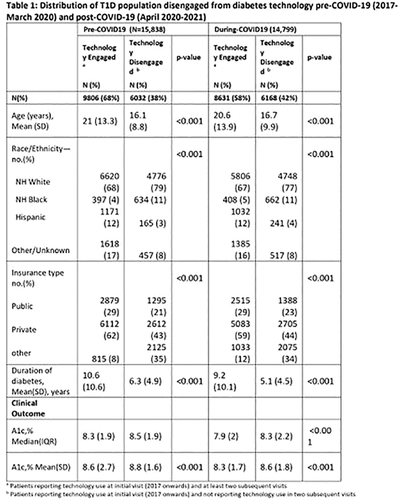Abstract: Impact of the COVID-19 Pandemic on Disengagement from Advanced Diabetes Technologies Among Racial/Ethnic Groups in the US T1D Exchange Quality Improvement Collaborative
S. Carrothers1, B. Lockee1, D. Williams1, E. DeWit1, R. McDonough1, N. Noor2, T. Alonso3, H. Akturk4, D.J. DeSalvo5, M. Kamboj6, L. Jacobsen7, M.L Scott8, A. Mungmode2, O. Ebekozien2, M. Clements1
1Children's Mercy, Kansas City, United States, 2T1D Exchange, Boston, United States, 3Barbara Davis Center Pediatrics, Denver, United States, 4Barbara Davis Center Adult, Denver, United States, 5Texas Children's Hospital, Houston, United States, 6Nationwide Children's Hospital, Columbus, United States, 7University of Florida Health, Gainesville, United States, 8University of Alabama, Birmingham, United States
Introduction: The use of continuous glucose monitors (CGM) and insulin pumps (PUMP) have been associated with improved outcomes in type 1 diabetes (T1D) care. Therefore, disengaging from these devices represents a risk for worsening health outcomes.
Objectives: We sought to evaluate the effect of the COVID-19 pandemic on device disengagement rates by race and ethnicity.
Methods: This retrospective cohort study Pre-COVID-19 [n = 15,838] + peri-COVID-19 ([n = 14,799]) used EMR data from 15 sites (i.e., 3 adult and 12 pediatric diabetes centers) within the T1D Exchange Quality Improvement Collaborative. We identified individuals using at least one Advanced Diabetes Technology (ADT [PUMP or CGM]) at their most recent visit. Individuals who continued to use that technology for at least two subsequent visits were classified as engaged. Those who reported not using ADT in two subsequent visits were classified as disengaged.
Results: Comparing pre-COVID-19 (January 2017–March 2020) to peri-COVID-19 (April 2020–2021) time periods, we observed increases in disengagement among non-Hispanic White (NHW; 42% to 45%, p = 0.03) and Hispanic (12% to 19%, p < 0.001) individuals. We found no difference among NH Black (NHB; 61% to 62%, p = 0.7) individuals.
Conclusions: The pandemic has presented self-care challenges for individuals with T1D, including continued use of ADT. NHB individuals exhibited the highest disengagement rates overall, while NHW/Hispanic individuals experienced significant pandemic-related increases in disengagement. Future research should evaluate the relative impact of intrinsic (i.e., patient-level) versus extrinsic (i.e., family-, environment-, and system-level) factors associated with race−/ethnicity-based differences in rate of disengagement.

